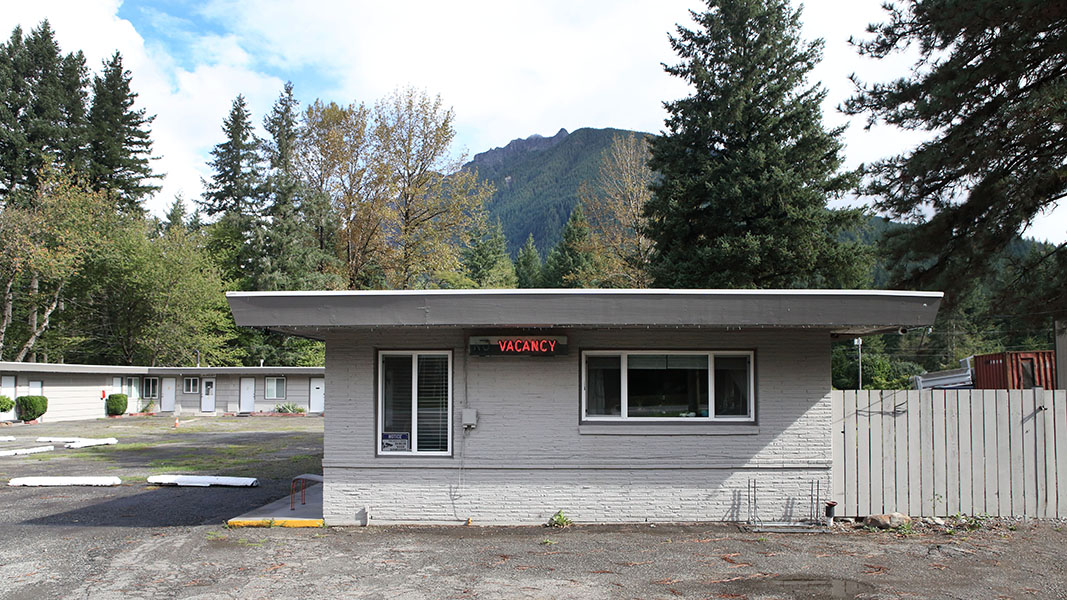“Mt Si Motel” by Steven Miller is licensed under CC BY-NC 2.0
August, 1992. We were a clean-looking 30ish couple arriving at the Mt. Si Motel in a shiny yellow Miata with Ontario plates. The motel manager quickly sized us up as High Probability Twin Peaks Fans.
“I’ll put you in Room 6,” she said in a conspiratorial tone, pushing a key across the counter. “It’s where Laura Palmer was murdered.”
She was right about us. My wife and I were on a jaunt to Twin Peaks country as part of a two-week road trip that took us out west through Canada then back to Toronto through the States. In fact we had just visited the tiny town of North Bend, where we had a regrettable meal at Twede’s Cafe—aka the Double-R Diner—enhanced by damn awful coffee and the complete absence of cherry pie. Norma Jennings didn’t work there anymore.
We hadn’t deliberately chosen the Mt. Si Motel, which appears briefly but memorably as the Red Diamond City Motel in the film Fire Walk With Me and has become a regular stop along the Twin Peaks pilgrimage trail. At the time of our visit the movie was just hitting theatres—we planned to go into Seattle the following day and catch a matinee—so we were unaware of the connection. All we knew was that out here, tucked into a pocket of landscape half an hour outside Seattle, the sun drops quickly behind the surrounding foothills and massive Douglas firs and we needed to find somewhere local to spend the night. In a David Lynch storyline, one might argue that we were compelled to come here by some primal spiritual alignment, that somehow the motel had chosen us. Truth is, darkness had already fallen and it was the only place for miles around with a vacancy.
“Okay, great,” we probably said, taking the key.
To reach Room 6, at the far corner of the U-shaped motel, we crossed an undulating gravely courtyard, skirting puddles of unknown depth that looked as if they’d formed in the 1950s, when the place was built, and hadn’t had the opportunity to dry up since. The starless sky seemed to descend like a blanket of gloom, granular gray fog fading to black, giving us the sense of becoming trapped on the inside of something—the belly of a slumbering malevolent creature for example. Other than our pineapple jellybean of a car, the only instance of color was the blood red neon sign reflecting in the murky puddle-water. We noticed that some rooms had adjoining garages—carports I guess you’d call them—occupied by a jumble of truck parts, unwanted furniture and tired toys. As big city out-of-towners we were stunned to realize that people lived here. Yet there were no immediate signs of life. No movement, no voices, no blue TV light flickering against drapes even though the hour wasn’t past anyone’s bedtime. Nevertheless, making our way across the courtyard we felt observed, and not by the good citizens of the Neighborhood Watch program. Upon reaching the room, inserting the key and entering, we discovered an unremarkable arrangement of bed, end tables and a TV mounted too high on a wall bracket—exactly the kind of sad, damp chamber promised so explicitly by the exterior, though far from the thrillingly blood-spattered crime scene hinted at by the manager. Our vaguely unsettled feeling was underscored by the Angelo Badalamenti music in a minor key that played on a loop through our heads. No wonder David Lynch chose this location: his art department would barely have to lift a finger to create the perfect spot for a grimy murder. I hardly slept, jolting myself awake every half-hour to listen for prowlers and peer out the window to see if our car had been stolen or vandalized yet.
Having spent the entire night unmurdered, the next morning we drove our unstolen, unvandalized car into central Seattle and found a cinema showing Fire Walk With Me. Sure enough, there onscreen was the Mt. Si Motel in all its creepy glory, misty mountain backdrop, spooky puddles and everything. And there was Laura Palmer and Ronette Pulaski in the very room we had checked out of only hours before, sitting on the very bed we had tossed and turned in all night. And there was Laura’s father, Leland, sneaking around outside. And there he was again, having transformed into his evil BOB alter ego, murdering her like a savage in that room, like the motel manager said.
That’s more or less what happens in the movie—except for the actual murder part. Laura Palmer wasn’t killed in Room 6 the Mt. Si Motel but, as every Twin Peaks folklorist knows, in an abandoned boxcar far away. I choose to ignore this detail. Someday I’ll ponder the cognitive uncoupling that causes my brain to insist on an incorrect memory about a movie—a movie I saw only once, thirty years ago—and if I do I might as well question everything I remember that happened once, thirty years ago. That’s a lot of messed up memories to sort through. Until I get around to doing that I’ll continue believing that my version of events is perfectly consistent with the swirling absurdity of every other aspect of Twin Peaks. Confusion and contradiction are part of the entertainment. I also think David Lynch would approve. After all, he’s the guy who told us the owls are not what they seem. By the looks of it, neither are memories, and that’s why they’re so wonderful. So for me, Laura Palmer was murdered in Room 6 of the Mt. Si Motel and I’m going to stick with that.
Paul Ruta grew up in Niagara Falls, Ontario and lives somewhere else now. He writes for children under the pen name Andy Spearman and reads prose for No Contact magazine. He regularly updates his website: paulthomasruta.com

